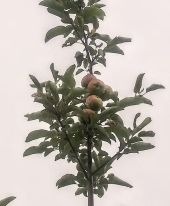Hi Emmett. Welcome. Thanks for starting such an excellent topic.
A couple of thoughts come to mind regarding they "why" of pruning.
First, it seems somewhat counter-intuitive, but when you are growing trees for fruit, less blossoms and less pollination is often better than more. If you are feeding your soil regularly (mulching, top dressing with
compost, etc.), and you have adequate moisture and sunlight, your trees will grow aggressively. They will also bloom aggressively and will attract a lot of bees. Suddenly, you are faced with the problem of having way more pollinated blossoms than your tree can reasonably support, so you have to get out there and thin the fruit. There is an optimum amount of fruit set that you want. An un-pruned tree will usually over-fruit set, leaving you a lot of extra work to thin it.
Second, related to the first point, it's hard to reach up into the branches to thin and pick when the tree scaffolding is so thick that you can't get your body into the inner structure of the tree. The old saw is that you want to prune heavy enough so that a bird can easily fly through, but not so much that you could throw a cat through it. (I love that visually imagery --- a cat flying through the air). For my mature trees, I like to be able to walk right into the heart of the tree and be able to reach all the fruit growing within the heart of the branch scaffolding. So for both thinning and picking, I like the structure of the tree to be open enough so that I can easily reach all the fruit.
Third, and perhaps this is obvious: I want large fruit. Quality is more important than quantity. It's hard to do much with a small apple, once you've pealed it and cored it. So one large apple is better than 3 smallish ones. Having twice as many branches producing twice as many apples doesn't make sense. In a permaculture garden, production usually outpaces your capacity of use all your produce, so I'd rather have big healthy fruits and veggies as opposed to buckets and buckets of small fruit. With the exception of citrus, cherries, apricots and avocados, I thin all my fruit trees to get nice large fruit. I've got about 20 different pom fruits and stone fruits --- all of them are thinned ruthlessly. 40 good-sized peaches is preferable to 100 little dinky fruits. Thus, you prune away a lot of the extraneous branches so that the tree's energy is focused on much less fruit.
Fourth, the goal of pruning is to allow sunlight to penetrate into the tree and feed the lower limbs without wasting a single photon onto the ground. That's a tricky balance. In my case, I've got a lot of good stuff growing beneath my fruit trees—ginger, herbs, comfrey . . . so I don't mind a bit more sunlight shining all the way through. At the end of your pruning, you want every branch to be equally productive: both those at the very top as well as those on the lowest levels.
Fifth, heavy, drooping, leggy branches are an invitation to snap-off. There is an art to finding that balance between letting the tree express its tree-ness, and doing what is best for it in the long-run. It's a bit like parenting children, finding the balance in giving structure for healthy maturation without over-parenting. A mature forest imposes a structure upon the trees growing within it. In a mature old-growth forest, only one baby tree ultimately grows to replace the 1000 year-old beech or redwood that parented it, despite the millions and millions of seeds that are produced. But in a garden, we have to impose that structure upon the trees therein. Gently shaping the tree over time, taking your time and being prudent in your selection of what to trim and what to leave . . . be an attentive parent, but not controlling. Over the years, you'll get to know your individual trees and have a sense for how they do best.
Finally, related to the idea of allowing sunlight to filter through and equally hit all the branches of the tree, top and bottom, inner and outer, you also want airflow to move through your trees equally. Fungal diseases more readily spread in densely bunched branches where the air can't circulate and keep things dry. I'd rather have the sunlight and the breeze take care of those fungal spores rather than have to spray to control them. So you don't want just the tops and outsides of your tree to get airflow, but also the inside. Rubbing branches are an invitation for a sore to develop along a branch, making an opening for a pathogen to enter.
Those are just a few thoughts.
Here is the best video I've seen on the "how" question, although he does touch a bit on the "why" question.
Best of luck.

 2
2




 3
3








 whilst if I followed Marcos philosophy I would still gave about 60 which is what I started with.
whilst if I followed Marcos philosophy I would still gave about 60 which is what I started with.








 2
2














